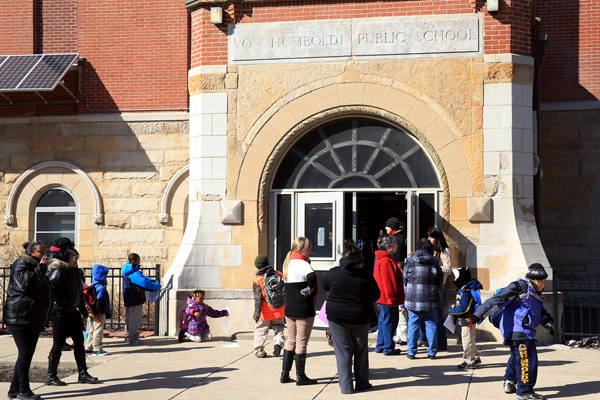
Heather Charles/Chicago Tribune
Von Humboldt Elementary School, one of 52 elementary schools planned for closure by CPS
In today's Sun-Times, Mary Mitchell argues strongly in favor of Chicago Public Schools' plan to close 54 schools and merge or "co-locate" others. You may or may not agree with her argument; but she relies on a frustrating old columnist trick to get there, even though her column would be little different without it:
"Gone are the days when you could kiss your kids goodbye and send them off to a decent school down the block."
This follows a litany of charges against those in opposition to the plan, such as: "Where were they when neighborhoods became so dangerous, a lot of these students had to hook up with gang-members just so they could get back and forth to school?"
I was curious when those days were, so I started doing some research. As far as the gang violence question, if those critics are my age, they were probably in grade school, if that. From "Gangs Reap More Blame for Dropouts," published in the Tribune on July 14, 1985 (I started kindergarten that fall):
Joining a West Side gang in his freshman year at Harrison High School meant Hector Gonzalez could walk safely into gang-controlled classrooms.
But the Puerto Rican youth got more than he asked for when fellow gang members demanded that he help protect their turf. He was ordered to shoot rivals, some of whom were his friends.
Gonzalez refused, and so became a target of the gang that once protected him.
[snip]
Gang recruitment and intimidation of students are increasingly becoming key contributors to a citywide dropout rate of 43 percent, school officials concede.
That year the state found that gang intimidation was the number one reason boys dropped out of school; pregnancy was the main reason for girls.
Had the dropout rate gotten worse in 1985, two years before William Bennett declared Chicago schools the worst in the country? Not really. From 1982-1985, it started at 45 percent, dropped to 40, then climbed to 43. This was actually better than the end of the prior decade, when a collaboration between the Chicago Reporter and the Better Government Association found the dropout rate increased from 51 percent in 1977 to 55 percent in 1979.
Were the 1970s better? History doesn't seem to bear it out. Take Ryerson Elementary, one of the schools CPS plans to close, and one of the better ones—a Level 2 school with above average student growth and below average student performance (31 percent perform at or above the national average in reading, according to CPS metrics, but recent cohorts have improved from grades 3-8, reaching 73 percent in reading by 8th grade).
In 1976, the average 13-year-old at Ryerson read at a 4th grade level (Chicago Tribune, 10/24/1976):
As the surrounding area changed from white to black, Ryerson became inundated with children. Enrollment skyrocketed to 2,600 at one point [it's currently 400], and 22 mobile classrooms filled virtually every inch of the school playground.
Ryerson was forced to a triple-shift schedule, and instructional time for each child was cut from 5 hours to 3 1/2 hours from 1969 to 1973. Many of the 13-year-olds whose scores last spring were so poor were victims of the cutbacks, said Donald J. Schmitt, Ryerson's principal.
If you push back all the way to the 1960s, you can finally find a high school graduation rate comparable to what it is now: 64 percent, according to a 1965 Tribune report, though that includes parochial schools as well. That's two points less than that of CPS students up to age 19 in 2010, as the University of Chicago's Consortium on Chicago School Research found in a study of the past two decades of educational reform in Chicago (PDF).
(Rather than a descent from decent schools around the corner, the CCSR found impressive gains in graduation rates, modest gains in math, none in reading, and increased racial gaps—mixed results, but not a narrative of decline.)
1965 represented the end of Benjamin Willis's long tenure. His "Willis Wagons" live in infamy, but they were intended to address a worse problem:
By 1960 Chicago's African American population had surpassed 800,000, almost a quarter of the city's total—up from 14 percent just 10 years earlier. Vast areas of the South and West Sides became densely populated ghetto neighborhoods, and racial segregation was high. Schools in these areas were overcrowded, and some ran on double shifts, with children attending for just half a day. In poor inner-city areas the annual turnover of students exceeded 50 percent, and in some instances it approached 100 percent. Schools in these neighborhoods often fell into disrepair.
In 1961, according to Willis, some thirty thousand Chicago schoolkids were attending split-shift schools; a couple years prior, the average class size was 38. Willis was reviled for his unwillingness to address racial inequities in the school system, perhaps hamstrung by the political climate, but he did push class sizes down from 40 to 32, in part by building over 200 schools.
And even then, Willis had his back-in-my-day critics. Back in the 1930s, a Mrs. June Snell wrote the Tribune, they didn't need effete things like small class sizes: "Thirty years ago I attended the Chicago schools and was on double shifts for over two years. When finally we had regular daily schedules there were 50 pupils in a class…. As I reflect, I feel I had as good an education as anyone today, if not better; and I believe it was all due to the attitude of the teachers, parents, and those in charge, and nothing else."


